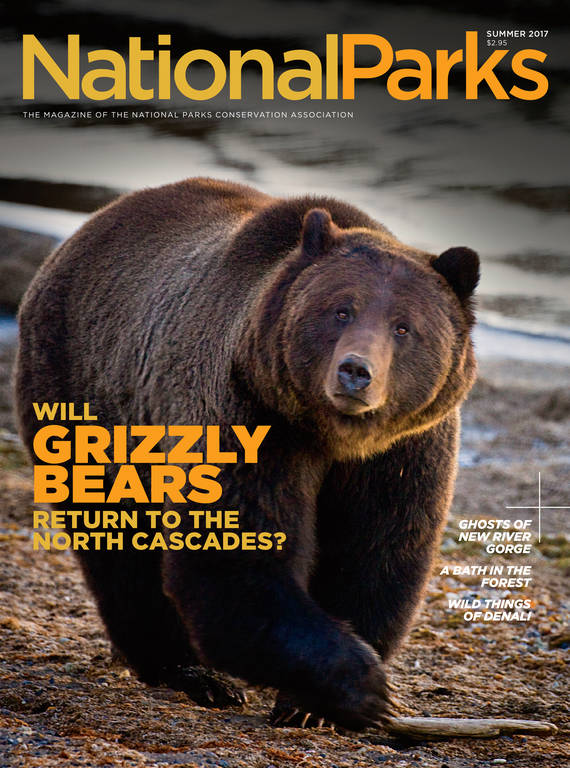Summer 2017
Where the Wild Things Were
Denali paleontologists brave blizzards and bears to find fossils that could challenge what we know about dinosaurs.
Small raindrops sifted down as Denali National Park paleontologist Cassi Knight and I tiptoed over creek stones, swatted away willows turning brassy with autumn and called out to ward off grizzly bears. It was a cool, damp September day, and we were following a loose social trail that leads from the Denali Park Road up a drainage near Sable Mountain. Knight’s mission was to sleuth out a new fossil site on a flank of the mountain that paleontologists hadn’t yet explored.
After about a mile and a half of hiking through rocky hills under the gloom of thick clouds, we arrived at a talus slope where Knight had found fossils before. Visitors have begun to come here looking for them. Wary of drawing more attention to the site, she made me promise not to disclose the exact location.
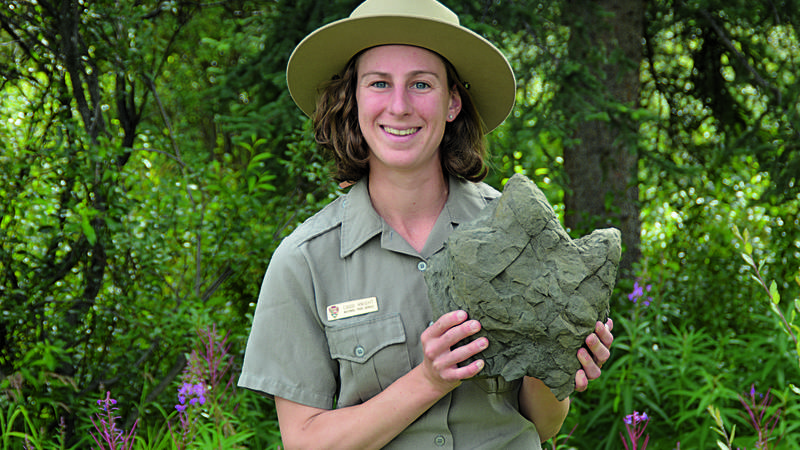
Paleontologist Cassi Knight holds a dinosaur track found in Denali.
PHOTO COURTESY OF CASSI KNIGHTPulling on winter hats and cinching up our hoods in the face of a rising wind, we poked about the rubble, a river of rocks pouring out of a cleft between hills. Knight set off to look for a particularly good specimen she had found on an earlier trip. Slim and bird-like in build, she moved with the strength and sure-footedness of a mountain goat.
She located it amid the stones, and I came over to where she was squatting, inspecting the bulbous, rough-surfaced three-toed track of a hadrosaur. At least 15 inches long, it was evidence of an animal bigger than any I had ever seen, dead or alive. Nearby, she showed me a dinosaur track site, a dark upturned boulder the size of a small billboard littered with the outlines of jumbled tracks, all cast in mud, then hardened and fossilized.
Using Google Earth, Knight, whose job as a field technician is to find new fossils, had spotted a landslide on the other side of the mountain that had never been surveyed. Our plan was to reach the saddle, ascend the ridge and drop into the steep, exposed talus on the other side.
As we climbed up into the treeless alpine tundra, a vista of snowy peaks and churning clouds unspooled behind us. The wind kicked up, and by the time we reached the saddle, it screamed in our faces, making our noses run and our eyes water. We staggered up the open grassy ridge, trying to keep our feet connected to the earth. Finally, Knight, a few feet ahead of me, turned around.
“This is borderline!” she yelled over the gale, tears from the cold escaping sideways from her eyes. It was beginning to feel as if the wind might pick us clear off the mountain if we proceeded. She leaned over, bracing against it. We decided to retreat. If there are fossils hiding in that drainage, they remain undiscovered.
It wasn’t the first time a paleontologist had been forced to turn back in Denali National Park and Preserve. The region’s long winters and fierce conditions — high winds, extreme cold, rain, sleet, snow, bears and bugs, to name a few — have helped keep Denali’s trove of plant fossils and dinosaur tracks secret for decades. But since the first track was discovered in 2005, researchers have slogged through raging rivers, bushwhacked through head-high willow thickets, and braved blizzards and thunderstorms to discover new specimens. Over the last 12 years, they’ve identified more than 270 fossil sites in the 70-million-year-old Cantwell Formation, sedimentary rock formed by the deposition of mud, sand, silt and stones by ancient rivers. New discoveries are unearthed every year, helping scientists understand one of the most exciting frontiers of paleontology: polar dinosaurs.
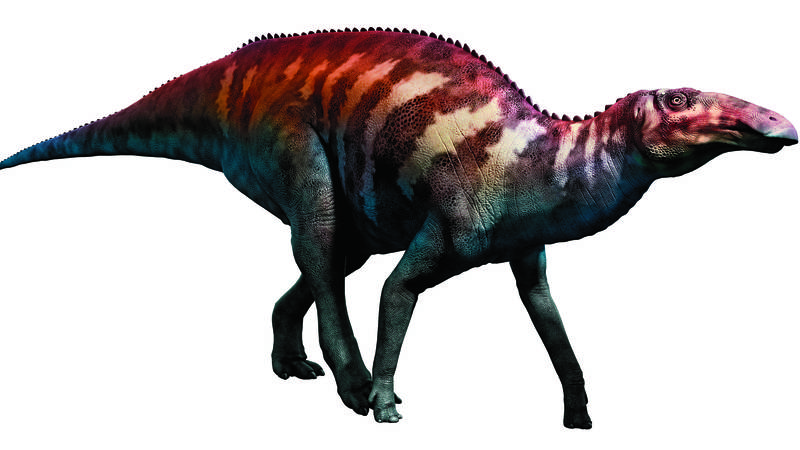
Duck-billed dinosaurs such as this Edmontosaurus may have roamed Denali’s landscape.
© MARK TURNER/ALAMY STOCK PHOTOThe first evidence of dinosaurs that lived near the poles surfaced in the 1960s in Norway, and paleontologists are still grappling with the questions these discoveries in higher latitudes have sparked. (Polar dinosaurs lived either north of the Arctic Circle or south of the Antarctic Circle, but their fossils can be found at lower latitudes such as southern Australia because tectonic plates have shifted over time.) Previously, for example, all dinosaurs were thought to be cold-blooded, like today’s reptiles, meaning their body temperatures would have been only a little warmer than the environment and the animals would get sluggish when temperatures dipped. But then how would they have adapted to the sunless days of polar winters? Did they migrate to warmer climes, hibernate or tough it out? (There is some evidence that a few small dinosaurs hibernated.) Is it possible that all dinosaurs were in fact warm-blooded or some cross between cold- and warm-blooded?
“These are active areas of research,” said Pat Druckenmiller, a paleontology professor at the University of Alaska Fairbanks and earth sciences curator for the University of Alaska Museum. As paleontologists, “what we know the least about is dinosaurs that lived in the high latitudes … and pound for pound, Alaska is the best place on the planet for polar dinosaurs, period.”
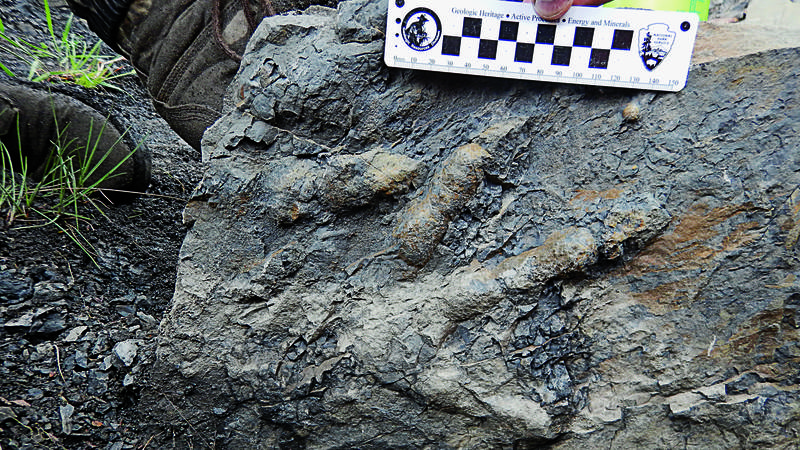
An exceptionally well-preserved footprint of a carnivorous theropod dinosaur discovered in Denali.
© PATRICK DRUCKENMILLER/UNIVERSITY OF ALASKA MUSEUMThe original discovery of dinosaur tracks is now part of Denali’s lore. In 2005, Paul McCarthy, a geology professor from the University of Alaska Fairbanks, led a group of students on a field trip in Denali. One day, not far from the park road, he stood in front of an outcropping of sedimentary rock and explained that tracks and fossils had often been found in rocks similar in age and type to those in the Cantwell Formation but never in Denali. The group was looking at rocks McCarthy thought would be suitable for tracks when a student piped up, wondering if the three-toed outline just above the professor’s head might possibly be a dinosaur track. Now, that same hand-sized footprint of a theropod, a meat-eating beast related to Tyrannosaurus rex, is enshrined in glass in the park’s Murie Science and Learning Center.
Shortly after that first discovery, paleontologist Tony Fiorillo, chief curator for the Perot Museum of Nature and Science in Dallas, began leading field trips to search for fossils by helicopter and on foot. And in the late 2000s, the National Park Service started hiring summer interns to survey new areas for fossils.
One of the most exciting discoveries came in 2007. Fiorillo, geologist Stephen Hasiotis and paleontologist Yoshitsugu Kobayashi were scrambling about the backcountry near Cabin Peak when they stumbled upon the discovery of a lifetime: a stepped, wedge-shaped plane of rock the size of a football field, pocked with dinosaur footprints stretching into the distance.
“The three of us just stood there; we couldn’t even talk,” Fiorillo said. “The quality of footprints was amazing. The candy store door had just been thrown open to us.” It took a few years for the team to secure funding and make arrangements to return in a helicopter with surveying equipment and molding materials to make casts of the tracks, some preserved well enough to show the texture of the dinosaurs’ skin. Their work helped confirm that hadrosaurs — creatures that grew up to 40 feet long — lived in herds like elephants and likely overwintered in the area rather than migrated.
Over the years, many other discoveries have helped researchers piece together a remarkably complete record of this vibrant Cretaceous ecosystem. By looking at the size, shape, margins and tips of fossilized leaves — some even show tiny veins and insect damage — paleontologists have been able to get an idea of the climate of that period. (Conditions were more temperate, like today’s Pacific Northwest.) Dinosaur and bird tracks shed light on what species roamed here, and trackways — where several footprints appear in a row — show how dinosaurs walked, ran and interacted. In Denali, there are other types of trace fossils, which include fossilized raindrop marks, worm tracks and beak holes where birds poked the ground in search of food. Coprolites, pieces of fossilized excrement, show what these extinct critters ate.
Imagine a landscape where redwood-like metasequoias towered over the hills; slim alder-like trees, ginkgos and vines dwelled at the forest margins; and lush ferns, cycads and horsetails packed the swamps. Horned dinosaurs, relatives of the Triceratops, grew to 20 feet long and munched the low-lying plants. Duck-billed hadrosaurs roamed in great herds, leaving tracks as small as softballs and as large as hula hoops. Pterosaurs with 13-foot-wide wingspans swept through the air, and fierce, predatory theropods stalked the herbivores.
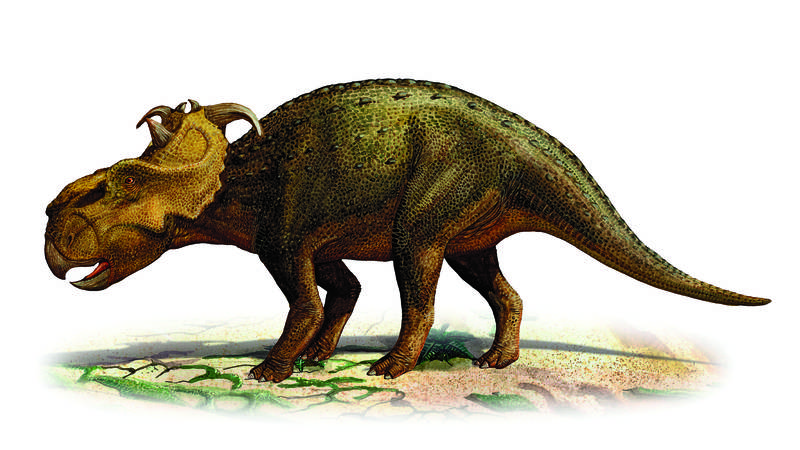
Horned dinosaurs, such as this Pachyrhinosaurus canadensis, likely lived in the Denali area.
© SERGEY KRASOVSKIY/STOCKTREK IMAGES, INC./ALAMY STOCK PHOTOBecause of the drifting of tectonic plates over millennia, these tracks might have been laid down farther north by as much as five degrees of latitude — about 350 miles. Although temperatures likely averaged in the 50s, Druckenmiller said it may have snowed during the colder months. Days and nights stretched to 24 hours long at the solstices.
Last summer, Druckenmiller started a five-year project in Denali, a partnership with the Park Service that aims to investigate the mysteries surrounding polar dinosaurs, unearth new species and answer one of the questions that dogged researchers for years — until recently: Why does Denali harbor so many fossilized plants and tracks but no bones?
In July, working with Knight and Tyler Hunt, a master’s student in paleontology at the University of Oklahoma and a summer intern for the park, Druckenmiller led a group of students to Denali to do 12 days of field work. On the first day, the group split up, some taking the high route along a ridge near Sable Mountain and others taking a low route, scanning as they negotiated the talus. While picking about the stones, Heather MacFarlane, a research assistant, found something unusual: a small blue-hued rock. She bent down and picked it up.
“Heather’s like, ‘Oh, hey, what is this? Is this some kind of mineral?’” recalled Knight, who was hiking nearby. Hunt went over to take a look, and his eyes widened. “I go over and look at it, and it’s totally bone,” he said. “It’s really actually bone. I was kind of freaking out for a minute about how crazy cool that was.” It was the first fossilized bone found in Denali National Park.
Bones and teeth are particularly valuable because they can offer researchers information about these animals that tracks cannot. By cutting them into tiny slices, scientists can examine the microscopic structure of the tissues, which can reveal the animal’s genus and sometimes species, its age and its growth rate. (Warm-blooded animals typically have faster growth rates than cold-blooded organisms.) The team believes that at least one of last summer’s fragments came from an adult duck-billed dinosaur.
Druckenmiller’s team and the park staff also found an enormous dinosaur tracksite they’re calling the Coliseum as well as bone fragments, tracks and trace fossils. Druckenmiller also is excavating sites in northern Alaska dating from the same period. Those discoveries, which include dinosaur teeth and bones, can be cross-referenced to identify tracks in Denali.
“We’re at this point of discovery and understanding here in Alaska that’s comparable to where the Lower 48 or Canada was in the 1930s or ’40s,” Druckenmiller said. “There’s probably a lot more out there to study, and we’ve only scratched the tip of the iceberg.”
The day after I went to look for fossils with Knight, I woke to dark clouds hanging low like a somber mood over the park. I boarded the park bus, which travels the winding 92-mile road for about eight hours round-trip. It’s the means by which the majority of visitors see Denali. Through the window, I watched the landscape unfold: valleys tinted burnt red with fall leaves, snowy peaks, a couple of moose, a grizzly bear sow with two cubs and dozens of Dall sheep.
It occurred to me that most visitors likely have no idea that Denali, known for its namesake peak (which shed its clouds only once during my stay) and its bears, wolves and moose, is also on the frontier of paleontological science. The Murie Science and Learning Center displays several large tracks and an interactive exhibit about the species that once lived here. But from the park bus, travelers can’t see evidence of the prehistoric creatures that once roamed the area, and only a small percentage of people venture out into the backcountry. Rangers would like more visitors to know about these finds, but sharing fossil sites comes with concerns.
“We don’t want these to be things that people just hear about,” said Denny Capps, the park geologist who oversees the paleontology program. “We’re trying to make it a much richer experience for them but also maintain these resources in the best condition we can. It’s the classic conflict between preserving the natural environment and providing for the enjoyment of the people.”
In the fall, Knight worked on a paleontological resources management plan that will guide how field staff keep records, interpreters share information about fossils and law enforcement officials respond to vandalism and theft. (So far there has been little evidence of either problem, partly because there aren’t many fossils small enough to carry. One man, however, apparently plagued by guilt, recently sent back a small fossil of a leaf he filched in the ’90s.)

National Parks
You can read this and other stories about history, nature, culture, art, conservation, travel, science and more in National Parks magazine. Your tax-deductible membership donation of $25 or more entitles…
See more ›Federal regulations largely prevent national park staff from revealing where fossils are located, but each park has some flexibility in the interpretation of the rules. Knight proposed allowing interpretive rangers to tell visitors about certain sites if asked but to refrain from sharing directions to areas with specimens that are exceptionally valuable to science. Still, that doesn’t mean that backcountry travelers don’t find them on their own. Every year, people with no paleontology or geology experience stumble upon fossils in the park.
“When Denali was set aside back in 1917 to protect the current ecosystem, including the sheep that were being hunted down, we didn’t recognize that we also had an intact Cretaceous ecosystem,” Capps said. “Now, any new resources we find are also protected. It helps explain the importance of parks — we still don’t know what’s out there.”
This tantalizing mystery is exactly what motivates paleontologists to continue to slog through knee-deep mud, stand up to 500-pound grizzlies and withstand punishing rainstorms: What great evidence of past worlds hides in these 6 million acres of roadless valleys, mountains, taiga and tundra?
About the author
-
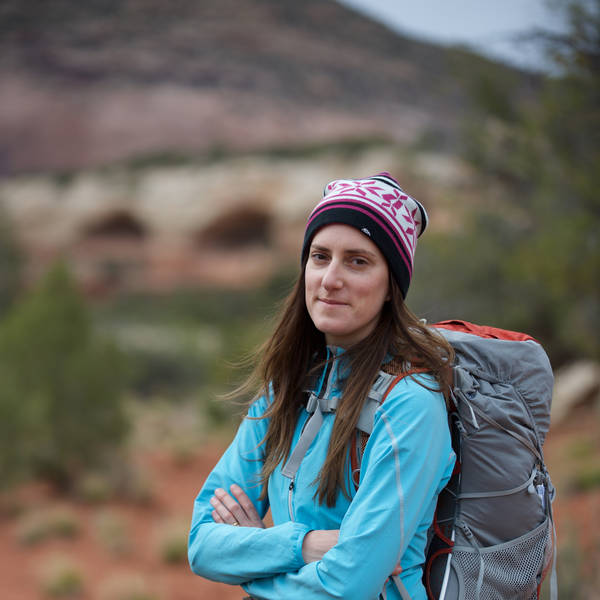 Kate Siber Contributor
Kate Siber ContributorKate Siber, a freelance writer and correspondent for Outside magazine, is based in Durango, Colorado. Her writing has appeared in National Geographic Traveler and The New York Times. She is also the author of “National Parks of the U.S.A.,” a best-selling children’s book.
